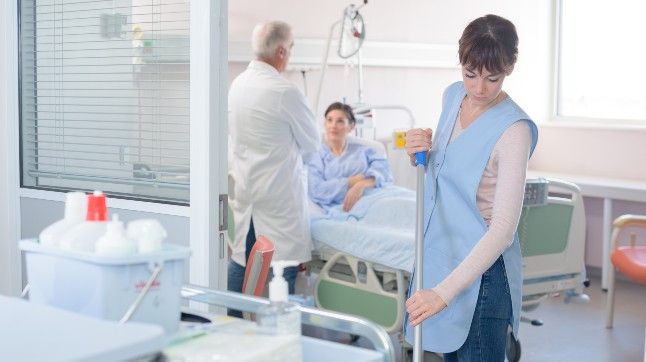Comparing Automated Room Decontamination Devices to Keep HAIs Low
Choosing which device to use may depend on the bacteria prevalent in the laboratory or patient room.
(Adobe Stock)

Infection prevention and control (IPC) teams, hospital managers, and hospital-based service providers must fight daily to clean and disinfect to keep rates of hospital-acquired infections (HAIs) low. Although conventional cleaning and disinfection can be effective, recently automated systems have become available to help supplement those established practices. These automated systems offer effectiveness and safety, and are now available in patient settings, not just in the laboratory.
The available choices of fumigation systems have increased dramatically, and the options and prices for health care professionals can be overwhelming. A recent report by the Working Party in The Journal of Hospital Infection lists clear pros and cons for many of the systems, which helps readers decide whether to rent/lease or purchase one.
Healthcare Infection Society (HIS) commissioned the Working Party “to provide guidance on the types of device[s] available, the various active chemicals (where relevant), the biocidal mechanism underpinning the technology, suggested information to be sought from the supplier before purchase, and general precautions recommended for the safe and effective use of the equipment,” according to the report.
Determining which kind of automatic cleaning device to supplement manual cleaning depends on the type of bacteria prevalent in each room. With Clostridioides difficile, methicillin-resistant Staphylococcus aureus, or vancomycin-resistant Enterococcus, the authors of the report recommend using an automated decontamination device. However, with an outbreak of Clostridioides difficile infection when other modalities have failed to reduce acquisition, the investigators recommend using hydrogen peroxide vapor or pulsed-xenon ultraviolet light in room surface decontamination.
Regardless of the automated cleaning devices used, manual cleaning must be completed to the same high standards. Also, infection prevention and control teams must monitor levels of fumigant or ultraviolet light regularly to confirm effectiveness.
The Working Party noted in the report that “[t]here was weak evidence regarding device-associated infection from an uncontrolled before–after study. Using PX-UV in addition to manual cleaning/disinfection, there was no statistically significant change in the incidence of CAUTI or CLABSI compared with manual cleaning/disinfection alone (P = .23 and P = .20, respectively).”
“There was weak evidence regarding infection of specific body organs or systems from an uncontrolled before–after study comparing PX-UV to manual cleaning/disinfection,” the report states. “Using PX-UV in addition to manual cleaning/disinfection, there were no inferential analyses reported regarding the incidence of enteric infection compared with manual cleaning/disinfection alone.” The authors did note, however, “statistically significant differences in the incidence of respiratory system infections, skin, and soft tissue infections, and UTIs (P = .017, P = .014 and P = .014, respectively).”
The Working Party said in the report that the potential for bias in the individual studies’ design, analysis, and reporting was noted, because all the “evidence was of very low or low quality.” The authors said, “in many cases imprecise estimates of treatment effects (as reflected by wide CrIs/CIs or those that crossed predetermined thresholds for precision).” In addition, the authors “emphasized the potential for bias when reporting study results in research funded by manufacturers of devices being evaluated.”
The investigators also listed proposals for future research. A few key recommendations are conducting trials to determine effectiveness of automated systems in preventing health care–acquired infections, including C. difficile, MRSA, and multidrug-resistant Gram-negative pathogens; and studying possible automated systems that could be used in patient bays without risk of toxicity to patients or staff.
Robust infectious disease surveillance, including rapid subtyping of influenza A, is essential for early detection, containment, and public health reporting of novel viral threats.